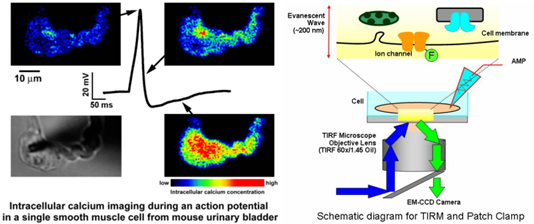Ion Channel
Research
Our research interests are concentrated on novel functions of ion channels in various types of cells under physiological conditions and also at pathophysiological settings and the development of drugs acting on ion channels. Ion channels are essential molecular components for the regulation of not only the membrane excitability in nerves and muscles but also the cellular functions in non-excitable cells such as immune cells and osseous cells. Since abnormal activity or dysfunction of ion channels is often the cause of diseases and/or pathological conditions, they are potential targets of drug therapy, such as sodium channel blockers for cardiac arrhythmia, calcium channel blockers for hypertension, and potassium channel inhibitors for type II diabetics. Drubs acting on ion channels are expected to be extensively developed in near future because of new lines of genomic information about molecular basis and diversity of ion channels and also of information about structural biology of ion channels.
(1) Biophysics and Molecular Pharmacology of K+ channels
K+ channels possess the largest diversity in structures, functions and distributions among ion channels and are considered to be potential targets for novel drugs with high selectivity and high tissue and/or cell specificity. We are working with enthusiasm on significant changes in distributions and functions of K+ channels, particularly Ca2+-activated K+ channels, in variety of diseases including cardiovascular diseases, urinary incontinent, prostate hypertrophy, malfunctioning gastrointestinal tract, asthma, immature birth and epilepsy. Gender difference in K+ channel distribution in brain and its changes by continuous exposure to drugs, including nicotine, and their implication are also topics on which we are now keenly working. Candidate compounds for novel drugs acting on several types of Ca2+-activated K+ channels have been discovered in our laboratory and the specific binding sites in channel molecule and mechanisms for modulating channel activity are under investigation.
(2) Bioimaging of Cellular Ion Dynamics and Ion Channel Molecules
Cellular Ca2+ mobilization is one of the key steps of signal transduction responsible for acute cellular responses such as transmitter release and also for proliferation and/or death of cells. Intracellular Ca2+ imaging with high time-resolution by Confocal Fluorescent Microscope gives significant information about functions of local Ca2+ transients in various types of cells, including an excitable urinary bladder smooth muscle cell, where excitation-contraction coupling mechanism has been clarified with this approach (right panel). Recently, new technology, which enables us to watch dynamics of single molecules labeled with fluorescent proteins as real time imaging in living cells by use of Total Internal Reflection Fluorescence Microscopy (TIRFM), has been developed. We use this method together under patch-clamping and are rushing to clarify the molecular interaction of ion channels with other regulatory molecules and their localization on cell membrane (left panel).


